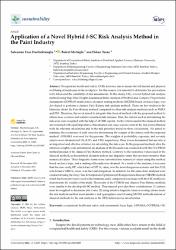| dc.contributor.author | Hacıbektaşoğlu, Süleyman Enes | |
| dc.contributor.author | Mertoğlu, Bülent | |
| dc.contributor.author | Tozan, Hakan | |
| dc.date.accessioned | 2021-12-24T06:12:50Z | |
| dc.date.available | 2021-12-24T06:12:50Z | |
| dc.date.issued | 2021 | en_US |
| dc.identifier.citation | Hacıbektaşoğlu, S. E., Mertoğlu, B. ve Tozan, H. (2021). Application of a novel hybrid f-sc risk analysis method in the paint industry. Sustainability (Switzerland), 13(24). https://doi.org/10.3390/su132413605 | en_US |
| dc.identifier.issn | 2071-1050 | |
| dc.identifier.uri | https://doi.org/10.3390/su132413605 | |
| dc.identifier.uri | https://hdl.handle.net/20.500.12511/8720 | |
| dc.description.abstract | Occupational health and safety (OHS) activities aim to ensure the full mental and physical well-being of employees in the workplace. For this reason, it is essential to determine the precautions to be taken and the suitability of risk assessments. In this study, f-SC, a novel hybrid risk analysis method using Step-Wise Weight Assessment Ratio Analysis (SWARA) and Complex Proportional Assessment (COPRAS) multi-criteria decision making methods (MCDM) based on fuzzy logic, was developed to perform a classical Fine–Kinney risk analysis method. There are few studies in the literature about the Fine–Kinney method compared to other risk analysis methods such as FMEA and FTA. Therefore, this work aimed to integrate this classical method with the proposed method to obtain more accurate and sensitive results in risk analyses. First, the criteria used in determining the risk score were weighted with the help of 10 OHS experts. As the criteria used in the classical method are evaluated with equal importance, this situation can cause serious errors in the risk scores obtained with the relevant calculations and in the risk priorities based on these calculations. We aimed to minimize the occurrence of such errors by determining the weights of the criteria with the proposed method. f-SWARA was used for this process. The weights of probability, exposure, and severity criteria were obtained as 0.196, 0.285, and 0.518, respectively. Thus, it was determined that severity is an important and effective criterion for calculating the risk score. In the proposed method, after the criterion weights were determined, an analysis of the hazards was conducted with the f-COPRAS method instead of the classical Fine–Kinney method. Contrary to the numerical values used in the classical method, in this method, decision makers use linguistic terms that are more intuitive than numerical values. These linguistic terms were converted into numerical values using this method based on fuzzy logic, and a ranking of hazards was obtained. As a result of the analyses, it was seen that the case study, H7, which had a 0.557 Ni value, was the most dangerous scenario and that H11, which had a 1.000 Ni value, was the least dangerous. In addition, for the same data, analyses were conducted using the fuzzy Vise Kriterijumska Optimizacija I Kompromisno Resenje (VIKOR) method, which has been previously used in the literature, and a comparison was made with the f-SC method to demonstrate the validity of the study. The results of the f-VIKOR and classical Fine–Kinney methods were similar to the developed f-SC method. This research provides three contributions: (1) criteria must be weighted to determine risk scores, (2) using intuitive linguistic terms in scoring criteria made the risk analysis method more sensitive and appropriate, and (3) using MCDM methods instead of classical methods for the risk analyses in the OHS field removes uncertainties. | en_US |
| dc.language.iso | eng | en_US |
| dc.publisher | MDPI | en_US |
| dc.rights | info:eu-repo/semantics/openAccess | en_US |
| dc.rights | Attribution 4.0 International | * |
| dc.rights.uri | https://creativecommons.org/licenses/by/4.0/ | * |
| dc.subject | F-COPRAS | en_US |
| dc.subject | F-SC | en_US |
| dc.subject | F-SWARA | en_US |
| dc.subject | Fuzzy Logic | en_US |
| dc.subject | Occupational Health and Safety | en_US |
| dc.subject | Risk Assessment | en_US |
| dc.title | Application of a novel hybrid f-sc risk analysis method in the paint industry | en_US |
| dc.type | article | en_US |
| dc.relation.ispartof | Sustainability (Switzerland) | en_US |
| dc.department | İstanbul Medipol Üniversitesi, Mühendislik ve Doğa Bilimleri Fakültesi, Endüstri Mühendisliği Bölümü | en_US |
| dc.authorid | 0000-0002-0479-6937 | en_US |
| dc.identifier.volume | 13 | en_US |
| dc.identifier.issue | 24 | en_US |
| dc.relation.publicationcategory | Makale - Uluslararası Hakemli Dergi - Kurum Öğretim Elemanı | en_US |
| dc.identifier.doi | 10.3390/su132413605 | en_US |
| dc.identifier.wosquality | Q2 | en_US |
| dc.identifier.scopusquality | Q1 | en_US |



















